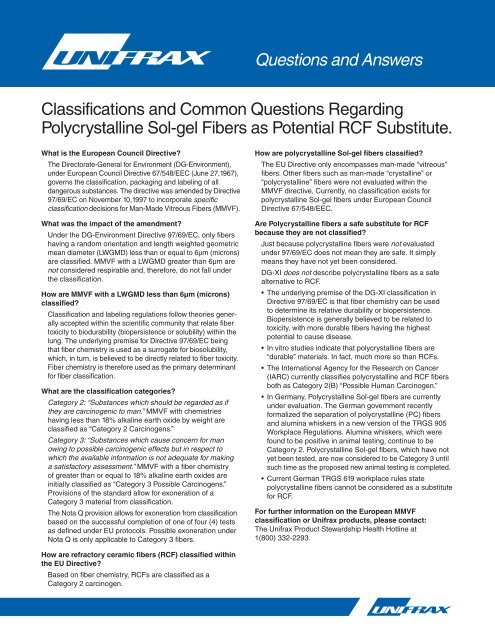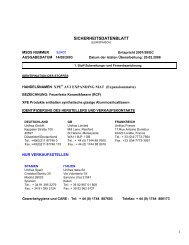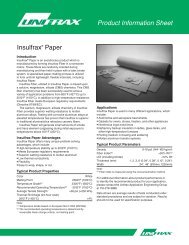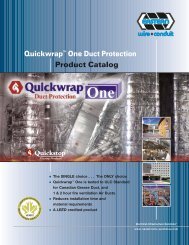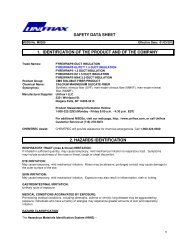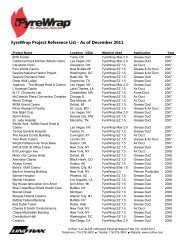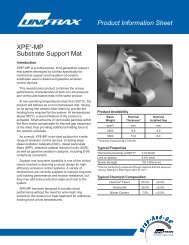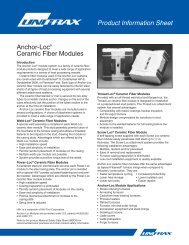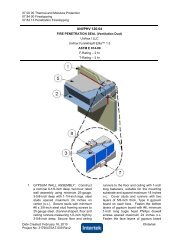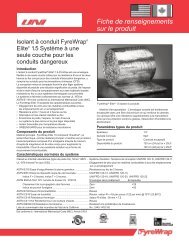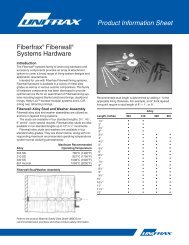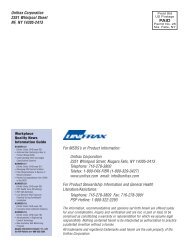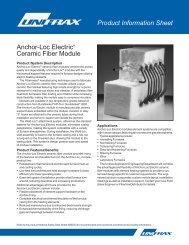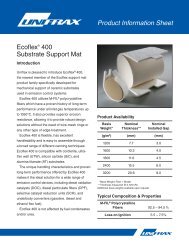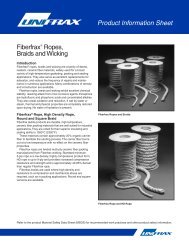Common Questions Regarding Polycrystalline Fibers as a ... - Unifrax
Common Questions Regarding Polycrystalline Fibers as a ... - Unifrax
Common Questions Regarding Polycrystalline Fibers as a ... - Unifrax
You also want an ePaper? Increase the reach of your titles
YUMPU automatically turns print PDFs into web optimized ePapers that Google loves.
<strong>Questions</strong> and AnswersCl<strong>as</strong>sifications and <strong>Common</strong> <strong>Questions</strong> <strong>Regarding</strong><strong>Polycrystalline</strong> Sol-gel <strong>Fibers</strong> <strong>as</strong> Potential RCF Substitute.What is the European Council Directive?The Directorate-General for Environment (DG-Environment),under European Council Directive 67/548/EEC (June 27,1967),governs the cl<strong>as</strong>sification, packaging and labeling of alldangerous substances. The directive w<strong>as</strong> amended by Directive97/69/EC on November 10,1997 to incorporate specificcl<strong>as</strong>sification decisions for Man-Made Vitreous <strong>Fibers</strong> (MMVF).What w<strong>as</strong> the impact of the amendment?Under the DG-Environment Directive 97/69/EC, only fibershaving a random orientation and length weighted geometricmean diameter (LWGMD) less than or equal to 6µm (microns)are cl<strong>as</strong>sified. MMVF with a LWGMD greater than 6µm arenot considered respirable and, therefore, do not fall underthe cl<strong>as</strong>sification.How are MMVF with a LWGMD less than 6µm (microns)cl<strong>as</strong>sified?Cl<strong>as</strong>sification and labeling regulations follow theories generallyaccepted within the scientific community that relate fibertoxicity to biodurability (biopersistence or solubility) within thelung. The underlying premise for Directive 97/69/EC beingthat fiber chemistry is used <strong>as</strong> a surrogate for biosolubility,which, in turn, is believed to be directly related to fiber toxicity.Fiber chemistry is therefore used <strong>as</strong> the primary determinantfor fiber cl<strong>as</strong>sification.What are the cl<strong>as</strong>sification categories?Category 2: “Substances which should be regarded <strong>as</strong> ifthey are carcinogenic to man.” MMVF with chemistrieshaving less than 18% alkaline earth oxide by weight arecl<strong>as</strong>sified <strong>as</strong> “Category 2 Carcinogens.”Category 3: “Substances which cause concern for manowing to possible carcinogenic effects but in respect towhich the available information is not adequate for makinga satisfactory <strong>as</strong>sessment.” MMVF with a fiber chemistryof greater than or equal to 18% alkaline earth oxides areinitially cl<strong>as</strong>sified <strong>as</strong> “Category 3 Possible Carcinogens.”Provisions of the standard allow for exoneration of aCategory 3 material from cl<strong>as</strong>sification.The Nota Q provision allows for exoneration from cl<strong>as</strong>sificationb<strong>as</strong>ed on the successful completion of one of four (4) tests<strong>as</strong> defined under EU protocols. Possible exoneration underNota Q is only applicable to Category 3 fibers.How are polycrystalline Sol-gel fibers cl<strong>as</strong>sified?The EU Directive only encomp<strong>as</strong>ses man-made “vitreous”fibers. Other fibers such <strong>as</strong> man-made “crystalline” or“polycrystalline” fibers were not evaluated within theMMVF directive. Currently, no cl<strong>as</strong>sification exists forpolycrystalline Sol-gel fibers under European CouncilDirective 67/548/EEC.Are <strong>Polycrystalline</strong> fibers a safe substitute for RCFbecause they are not cl<strong>as</strong>sified?Just because polycrystalline fibers were not evaluatedunder 97/69/EC does not mean they are safe. It simplymeans they have not yet been considered.DG-XI does not describe polycrystalline fibers <strong>as</strong> a safealternative to RCF.• The underlying premise of the DG-XI cl<strong>as</strong>sification inDirective 97/69/EC is that fiber chemistry can be usedto determine its relative durability or biopersistence.Biopersistence is generally believed to be related totoxicity, with more durable fibers having the highestpotential to cause dise<strong>as</strong>e.• In vitro studies indicate that polycrystalline fibers are“durable” materials. In fact, much more so than RCFs.• The International Agency for the Research on Cancer(IARC) currently cl<strong>as</strong>sifies polycrystalline and RCF fibersboth <strong>as</strong> Category 2(B) “Possible Human Carcinogen.”• In Germany, <strong>Polycrystalline</strong> Sol-gel fibers are currentlyunder evaluation. The German government recentlyformalized the separation of polycrystalline (PC) fibersand alumina whiskers in a new version of the TRGS 905Workplace Regulations. Alumina whiskers, which werefound to be positive in animal testing, continue to beCategory 2. <strong>Polycrystalline</strong> Sol-gel fibers, which have notyet been tested, are now considered to be Category 3 untilsuch time <strong>as</strong> the proposed new animal testing is completed.• Current German TRGS 619 workplace rules statepolycrystalline fibers cannot be considered <strong>as</strong> a substitutefor RCF.For further information on the European MMVFcl<strong>as</strong>sification or <strong>Unifrax</strong> products, ple<strong>as</strong>e contact:The <strong>Unifrax</strong> Product Stewardship Health Hotline at1(800) 332-2293.How are refractory ceramic fibers (RCF) cl<strong>as</strong>sified withinthe EU Directive?B<strong>as</strong>ed on fiber chemistry, RCFs are cl<strong>as</strong>sified <strong>as</strong> aCategory 2 carcinogen.
Form C-3080Effective 8/05© 2002, 2005 <strong>Unifrax</strong> CorporationAll Rights ReservedPrinted in USAThe test data shown are average results of tests conducted under standard proceduresand are subject to variation. Results should not be used for specification purposes.The following is a registered trademark of <strong>Unifrax</strong> Corporation: CC-Max.<strong>Unifrax</strong> CorporationCorporate Headquarters2351 Whirlpool StreetNiagara Falls, New York 14305-2413Telephone: 716-278-3800Telefax: 716-278-3900Internet: www.unifrax.comEmail: info@unifrax.com


